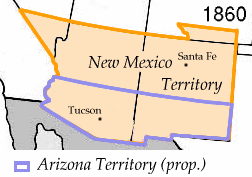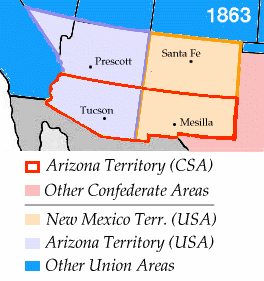Arizona Territory
|
|
|
Missing image |
The Arizona Territory was an organized territory of the United States that existed between 1863 and 1912, as well as a territory of the Confederate States of America that existed from 1861 to 1865. The two territories were overlapping but not identical in boundary. As such, they played a significant role in the western campaign of the American Civil War.
History
After the expansion of the New Mexico Territory in 1853 by the Gadsden Purchase, proposals for a division of the territory and the organization of a separate Territory of Arizona in the southern half of the territory were advanced as early as 1856. The first proposals for the Arizona Territory were not based on the current north-south division, but rather a division along an east-west line.
The proposals arose from concerns about the effectiveness of the territorial government of in Santa Fe to effectively administer the newly acquired southern portions of the territory [1] (http://home.sandiego.edu/~paulb/uscivilwar/atg.html).
The first proposal dates from a conference held in Tucson that convened on August 29, 1856. The conference issued a petition to the U.S. Congress, signed by 256 people, requesting organization of the territory and elected Nathan P. Cooke as the territorial delegate to Congress. In January 1857, the bill for the organization of the territory was introduced into the United States House of Representatives, but the proposal was defeated on the grounds that the population of the proposed territory was yet too small. Later a similar proposal was defeated in the Senate. The proposal for creation of the territory was controversial in part because of the perception that the New Mexico Territory was under the influence of southern sympathizers who were highly desirous of expanding slavery into the southwest.
In February 1858, the New Mexico territorial legislative adopted a resolution in favor of the creation of the Arizona territory, but with a north-south border along the 109th meridian, with the additional stipulation that all the Indians of New Mexico would be removed to northern Arizona.
In April 1860, impatient for Congress to act, a convention of thirty-one delegates met in Tucson and adopted a constitution for a provisional territorial government of the area south of 34 degrees north. The delegates elected L.S. Owings as provisional governor.
At the outbreak of the Civil War, sentiment in the territory was in favor of the Confederacy.
Early in war, the Confederacy regarded the territory as a valuable route for possible access to the Pacific Ocean, with the specific intention of capturing California. In July 1861, a small Confederate force of Texans under the command of Lieutenant Colonel John R. Baylor assaulted Fort Fillmore at Mesilla in the eastern part of the territory. After the fort was abandoned by the Union garrison, Baylor's force cut off the fleeing Union troops and forced them to surrender. On August 1, Baylor issued a "The Proclamation to the People of the Territory of Arizona", taking possession of the territory for the Confederacy, with Mesilla as the capital and himself as the governor. Baylor's subsequent dismantling of the existing Union forts in the territory left the white settlers at the mercy of the Apache, who quickly gained control of the area and forced many of the white settlers to seek refuge in Tucson.
On August 28, a convention met again in Tucson and declared that the territory formed the previous year was part of the Confederacy. Granville H. Oury was elected as delegate to the Confederate Congress. Oury drafted legislation authorizing the organization of the Confederate Territory of Arizona. The legislation passed on January 13, 1862, and the territory was officially created by proclamation of President Jefferson Davis on February 14.
The following month, in March 1862, the U.S. House of Representatives, now devoid of the southern delegates and controlled by Republicans, passed a bill to create the United States Arizona Territory using the north-south border of the 107th meridian. The use of a north-south border rather than an east-west one had the effect of denying a de facto ratification of the Confederate Arizona Territory. The house bill stipulated that Tucson was to be capital. The final bill passed the Senate in February 1863 without the Tuscon-as-capital stiputlation, and was signed into law by President Abraham Lincoln on February 24, the date of the official organization of the US Arizona Territory. The first capital was at Prescott, in the northern Union-controlled area.
In 1867, following the end of the Civil War, the capital was moved to Tucson, and in 1889 it was moved to Phoenix.
The territory was admitted to the Union as the 48th state on February 14, 1912.


